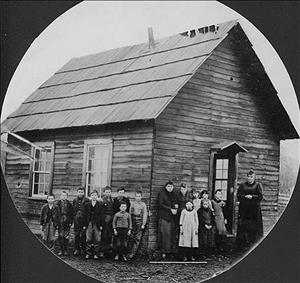Carnation (previously Tolt), a rural community along the Snoqualmie River in eastern King County, was founded early in the settlement of the county. The town was named after the world-famous Carnation Dairy, a dairy operation that located in Tolt in 1910. The confluence of the Tolt and Snoqualmie rivers has been the main village site for the Snoqualmie tribe for thousands of years. When non-Native settlers arrived in the 1850s, the tribe greeted them in a friendly manner, so much so that in 1855, Chief Patkanim ceded the valley and tribal sites to the United States, opening the way for many homesteaders. The city of Carnation has seen many changes over the years, not the least of which is its own name.
From Deserter to Respected Citizen
The first new settler in the area, James Entwistle, had deserted the U.S. Army at Fort Steilacoom (located along Puget Sound, just south of present-day Tacoma). Entwistle took up 169 acres of land at the confluence of the rivers, established a trading post, and later became successful in hop farming. At the time of his death in 1902, he was very well respected in the community.
Soon after Entwistle arrived, many others came to the valley to work the land. Once the heavy underbrush was cleared in the valley, small logging camps began dotting the hillsides. Skid roads (roads made of greased logs) were built from the hills to the Snoqualmie River, and they were used to get the logs down to the water. With the valley cleared of brush, the fertile land beneath was ready for farming.
Getting to Tolt from Seattle was no easy task, but many prospective farmers did. W. A. Templeton, writing in 1953, remembered as a child taking the ferry across Lake Washington, riding pack horses to Redmond, and then following 20 miles of trails to Tolt. Once at the river, goods were transported across in a large Indian canoe. By 1879, enough families were living in Tolt to necessitate the construction of a school, which was no more than a log shack. In 1882, schoolchildren moved to a larger building. In 1895, a proper schoolhouse was built. This grammar school would serve Tolt children for almost 40 years.
By the end of the nineteenth century, the community of Tolt mainly consisted of cabins, the school, a church, and a social club. On May 6, 1902, the town was platted and soon more businesses and services became available to the loggers, farmers, and their families. On New Years' Eve 1912, the town of Tolt was incorporated.
The Railroad Arrives
Many events, but especially the introduction of railroads to the area, led to the incorporation of Tolt. The Great Northern Railroad had reached Tolt from the north in 1910. In 1911, the Chicago, Milwaukee & St. Paul Railroad built a branch line from the South. The Milwaukee would later take over the Great Northern tracks up to Monroe, 15 miles to the north. The Milwaukee Railroad also built a railyard and depot in Tolt. The railroad introduced a fast and reliable method of transportation and permitted Tolt to become a boomtown. Before the railroad, logs and dairy goods had been shipped on the unreliable river, with its heavy flooding in the early spring and low water levels at the end of the summer.
Dairy farming was an economic staple for Tolt ever since the brush had been cleared, but Carnation Dairy put the town on the map. In 1910, Elbridge Amos Stuart cleared 350 acres of timber and brush and brought in a purebred bull and 86 registered Holstein cows to form a research herd. Two years later, he cleared 400 more acres, and today [1998] the farm rests on some 1,200 acres of land. The valley became world-famous as the "Home for Contented Cows." One cow from the herd, nicknamed "Possum Sweetheart," produced more than 37,000 pounds of milk in one year, a world record. Over the years many famous people visited the farm to see her, including boxer Jack Dempsey, who tried his hand at milking her.
What's In a Name?
In 1917, the town of Tolt changed its name to Carnation, in honor of the farms. This did not sit well with many Native Americans and early settlers. The area had always been known as Tolt, even before non-Native settlers arrived. The Snoqualmie name "Tolthue" (river of swift waters) had been in use for more than 10,000 years. To the Indians and pioneers, the use of the name Tolt over a few millennia of seemed like a good test of time.
Over the next few years, as resources dwindled, the logging camps ceased operations and the town's heyday was over. The swift changes that brought the community into being had reached a plateau, and since then the local farms have provided a steady economy. The controversy over the name change continued, though, and in 1928 the town decided to change the name back to Tolt. Unfortunately, the train depot and the post office names remained as Carnation, and for the next two decades, confusion reigned. Some maps showed the town as Tolt, some as Carnation. Some maps showed both.
Finally, in 1951, the city changed its name back to Carnation to end the discrepancies once and for all. In the late 1990s, with an estimated population of about 1,500 (U.S. Census Bureau, 1996), the town was officially named Carnation, but there are those who still call it Tolt. Some things you can't change.

